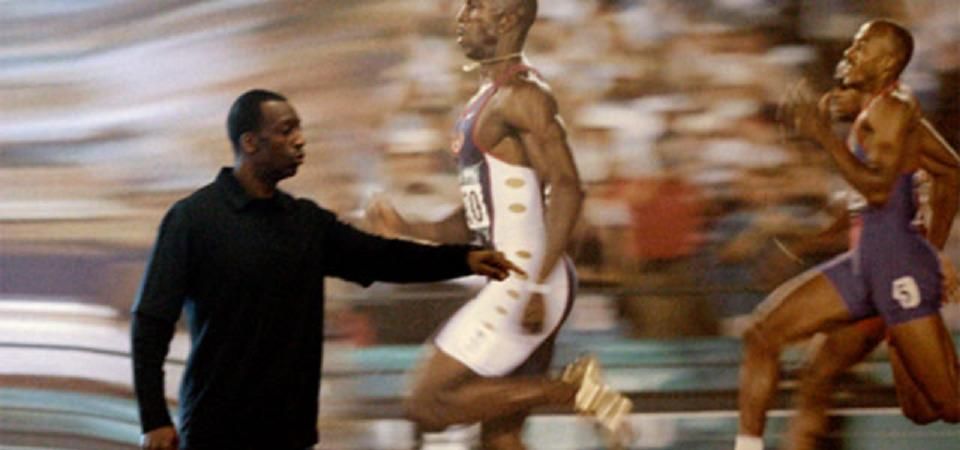A basic scientific look at 400m running
By Roy Barber (RunJumpThrow.com)
30th October 2013 Michael Johnson coaching at his performance centre in Texas. Photo by Jordan Whitley via Flickr.
Michael Johnson coaching at his performance centre in Texas. Photo by Jordan Whitley via Flickr.Globally the 400m is regarded by many as one of the hardest disciplines in track & field; it is a very complex event in which all three energy systems are working overtime to provide you with energy for the 45-50seconds of near maximal effort. It is also, unusually, a sprint event in which tactics play a key role in that you can’t sprint flat out the whole way so you need to formulate and execute a strategy to ensure optimal, efficient performance. In this article I plan to provide statistical look at the tactics employed by elite 400m runners and the physiology behind the event.
Tactics From a young age we are all told that as much as we might want to sprint all the way round the track as fast as we can it won’t work and instead we need to pace ourselves. The commonly taught and accepted method is that derived by Clyde Hart & Michael Johnson, which is referred to as the 4 P’s. These are Push, Poise, Position & Press (or pray!), essentially the objective is to go out hard for the first 100m or so, then relax and lengthen out down the back straight before picking up again and positioning yourself in the 3rd 100m before giving it all you’ve got left for the final straight. This approach is generally considered the optimal way of executing a 400m race, but in my experience can often be misinterpreted & poorly applied. The part that is most often misunderstood is the back straight, whilst the idea is indeed to settle into your running, relax and lengthen out your stride this section of the race should still be the fastest! Looking at statistical date from elite athletes you can see that, in fact, male runners go through the 100-200m section of a 400m race only around 0.2-0.3seconds slower than their 100m PB’s. For women it is generally slightly slower, around 0.3-0.5seconds slower than their 100m PB’s, but the intent is still there. In Michael Johnson’s World Record run of 43.18 for instance, he ran splits of 11.05,10.12,10.44 & 11.52. Clearly the optimal mechanism for successful 400m running then appears to be trying to cruise down the back straight, after building up speed around the first bend ( the highest velocity tends occur around 50-100m) and then maintaining that speed as much as possible whilst staying relaxed.
200m DifferentialsA calculation often used for predicting 400m performance is to take someone’s 200m PB then double it and add 3.5seconds. Data generally supports this and suggests that elite male athletes tend to run the first 200m of a race around 1second slower than their 200m PB/SB and then the second 200m around 1.3-1.7seconds slower than the first 200m- hence the overall difference being approximately 3.5seconds slower than 2x200PB.
Physiology – Why Lactate is NOT the bad guyAnyone who has ever attempted a 400m race will of undoubtedly experienced the intense feeling of heavy-leggedness, extreme fatigue and probably feeling quite sick. This is nearly always attributed to Lactate build up which supposedly causes the fatigue and inability to contract our muscles with much force. In actual fact Lactate appears to have no role in fatigue and is indeed very helpful and can aid us in maintaining force and velocity of contraction. It is actually thought to be primarily the accumulation of Hydrogen Ions, along with others such as inorganic phosphate and potassium build up, that dramatically inhibits the ability of our muscles to contract. When Lactate is produced it essentially helps to ‘mop up’ the Hydrogen ions (to form Lactic Acid) and helps us to continue exercising.
The importance of all 3 energy systems When reading articles from Clyde Hart, one of the world’s most successful 400m coaches, he regularly talks of the importance of the aerobic contribution to 400m running and that whilst previously thought that only around 5-10% of one’s energy was generated by aerobic metabolism during 400m running it is in fact much greater than that. Multiple studies over the past 20years or so have shown that there appears to be around a 40% aerobic contribution to the event, thus highlighting the importance of aerobic training for 400m runners. The remaining 60% comes from a combination of the Phosphocreatine system (predominant at the very start of the race) and the Lactate (Anaerobic Glycolysis) system. It is important to note here that all the 3 energy systems will have a contribution to energy from the start of the race, only their relative proportions will change.
You can see more info from some of the sources used at: http://bit.ly/HaYKVthttp://bit.ly/17SlyQp (Biomechanical Analysis of sprints & hurdles at berlin 2009)
http://bit.ly/17Q3UzU